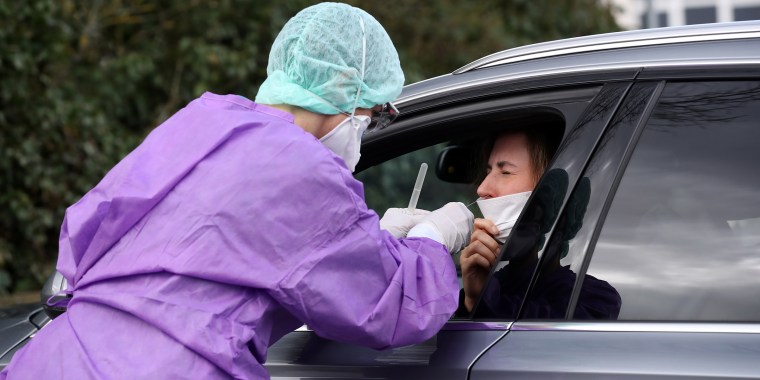As more Americans get tested for the new coronavirus and the disease it causes, COVID-19, they’re discovering the test involves a deep nasal swab that can be uncomfortable.
Called a nasopharyngeal swab or culture, it allows doctors to collect a sample of secretions from the uppermost part of the throat, behind the nose.
A health care worker will gently insert what looks like a long Q-tip as far as it’ll go into a person’s nose, twirl the swab to get a good sample, then remove it and place it in a vial, which is then sent to a lab for testing.
One TikTok user who filmed herself getting the coronavirus test in a drive-thru facility cringed, winced and coughed afterwards.
“Felt like I was being stabbed in the brain,” she wrote in the caption. “It’s awful, I’m sorry,” the health care worker is heard saying in the video. “I wish there was a better way to do it.”
President Trump, who also had a nasopharyngeal swab during his test, wasn’t a fan either. “Not something I want to do every day, I can tell you that,” he said during a news conference on Monday. “Nothing pleasant about it.”
Why it's done this way:
For most respiratory viruses, the best place to sample is the back of the nose, said Dr. Daniel Kuritzkes, chief of the division of infectious diseases at Brigham and Women's Hospital in Boston. When it comes to influenza, for example, nasopharyngeal sampling is much more sensitive and reliable than oral sampling, he noted.
“But you really need to get (the swab) back into the pharynx part of the nose, not the very front part, in order to get a good sample and have it be reliable,” Kuritzkes told TODAY.
“It can be moderately uncomfortable. It shouldn’t be painful. It’s not anybody’s pleasantest experience, but then getting a deep throat swab of the tonsils often makes some people gag.
“It’s unfortunate that it isn’t an easier procedure, but there are certainly many other things we do in medicine that are much less pleasant.”
The New England Journal of Medicine has a detailed video of what the test looks like:
Early on in testing for COVID-19, people were getting both a nasal and an oral swab because doctors didn’t know which would be most reliable, but because of swab shortages the test now involves doing just a single swab of the nose, Kuritzkes said. Other countries are following the same procedure.
People who are mildly symptomatic and in the early stages of infection have very high concentrations of the virus in their nasopharangeal secretions, so that’s a very good way of sampling the bug, Kuritzkes said. Saliva would be unreliable, he added.
The swab is quick — it takes just a few seconds. To make it smoother for both the individual and the health care worker, Kuritzkes advised people to try as best they could to relax. It’s not necessary to hold your breath during the test.
“Take a deep breath, bend your neck back… so that the person obtaining the test can go straight back to the nasal passages and that will make it as easy as possible,” he said.
As of March 17, almost 32,000 samples have been tested for the new coronavirus by Centers for Disease Control and Prevention labs and U.S. public health laboratories.

